Competitive Analysis of the Drone Industry: A Strategic Overview
VerifiedAdded on 2020/05/28
|22
|4633
|61
Report
AI Summary
This report provides a comprehensive analysis of the drone industry, examining its evolution, current state, and future prospects. It begins with an introduction to drones, tracing their development from military applications to their diverse uses across various sectors. The report then delves into the competitive environment, identifying key players like Parrot, DJI, and 3DR. A core component of the analysis is the application of Porter's Five Forces model to assess the industry's structure, evaluating the threat of new entrants, the bargaining power of customers and suppliers, the threat of substitute products, and the intensity of existing rivalry. The report also incorporates quantitative analysis, including market data and segmentation, to highlight growth trends and the economic factors driving the drone industry. Finally, the analysis considers the costs associated with drone development and manufacturing, offering a detailed view of the industry's financial dynamics and potential for growth. The report is designed to provide a strategic overview of the drone market, providing insights into its competitive landscape and future trajectory.
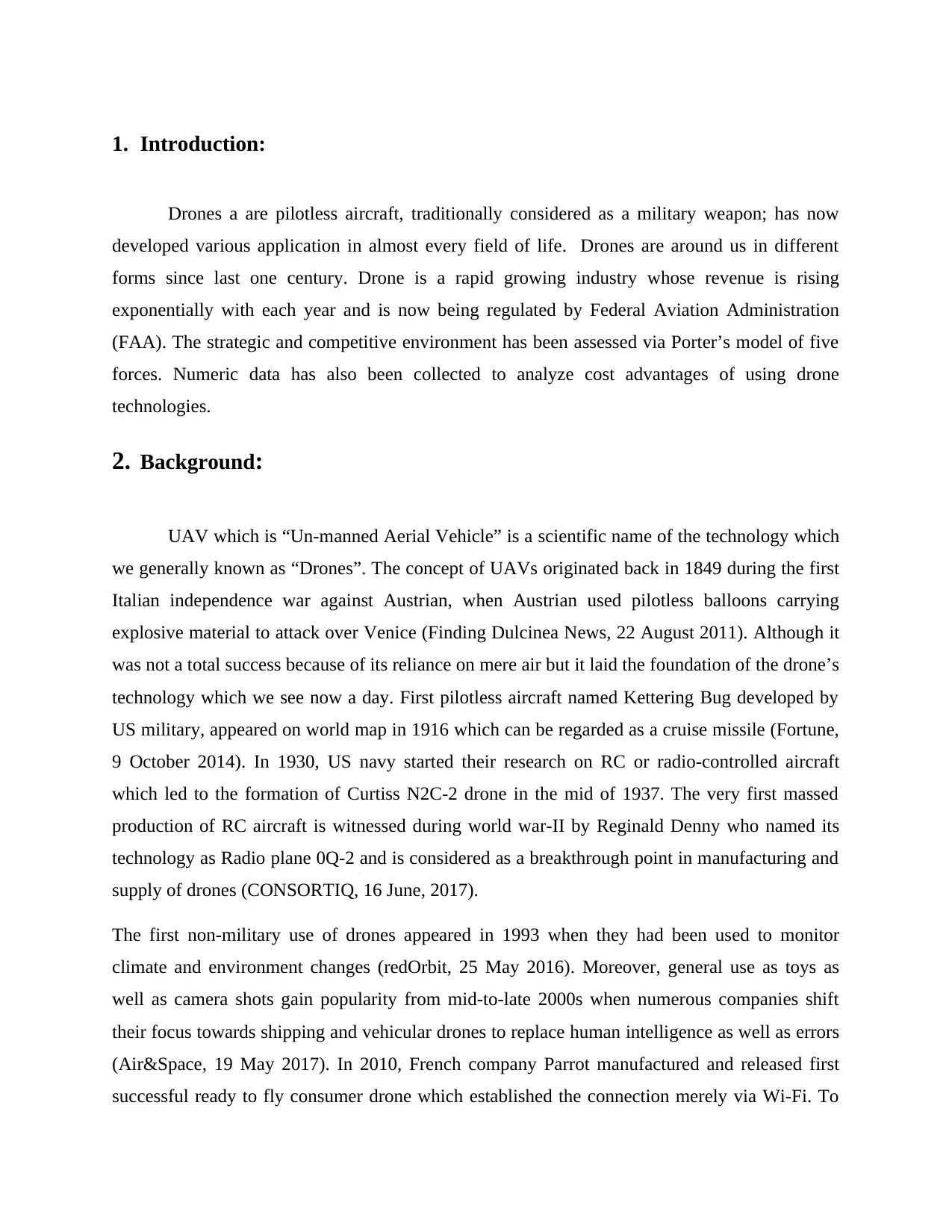
1. Introduction:
Drones a are pilotless aircraft, traditionally considered as a military weapon; has now
developed various application in almost every field of life. Drones are around us in different
forms since last one century. Drone is a rapid growing industry whose revenue is rising
exponentially with each year and is now being regulated by Federal Aviation Administration
(FAA). The strategic and competitive environment has been assessed via Porter’s model of five
forces. Numeric data has also been collected to analyze cost advantages of using drone
technologies.
2. Background:
UAV which is “Un-manned Aerial Vehicle” is a scientific name of the technology which
we generally known as “Drones”. The concept of UAVs originated back in 1849 during the first
Italian independence war against Austrian, when Austrian used pilotless balloons carrying
explosive material to attack over Venice (Finding Dulcinea News, 22 August 2011). Although it
was not a total success because of its reliance on mere air but it laid the foundation of the drone’s
technology which we see now a day. First pilotless aircraft named Kettering Bug developed by
US military, appeared on world map in 1916 which can be regarded as a cruise missile (Fortune,
9 October 2014). In 1930, US navy started their research on RC or radio-controlled aircraft
which led to the formation of Curtiss N2C-2 drone in the mid of 1937. The very first massed
production of RC aircraft is witnessed during world war-II by Reginald Denny who named its
technology as Radio plane 0Q-2 and is considered as a breakthrough point in manufacturing and
supply of drones (CONSORTIQ, 16 June, 2017).
The first non-military use of drones appeared in 1993 when they had been used to monitor
climate and environment changes (redOrbit, 25 May 2016). Moreover, general use as toys as
well as camera shots gain popularity from mid-to-late 2000s when numerous companies shift
their focus towards shipping and vehicular drones to replace human intelligence as well as errors
(Air&Space, 19 May 2017). In 2010, French company Parrot manufactured and released first
successful ready to fly consumer drone which established the connection merely via Wi-Fi. To
Drones a are pilotless aircraft, traditionally considered as a military weapon; has now
developed various application in almost every field of life. Drones are around us in different
forms since last one century. Drone is a rapid growing industry whose revenue is rising
exponentially with each year and is now being regulated by Federal Aviation Administration
(FAA). The strategic and competitive environment has been assessed via Porter’s model of five
forces. Numeric data has also been collected to analyze cost advantages of using drone
technologies.
2. Background:
UAV which is “Un-manned Aerial Vehicle” is a scientific name of the technology which
we generally known as “Drones”. The concept of UAVs originated back in 1849 during the first
Italian independence war against Austrian, when Austrian used pilotless balloons carrying
explosive material to attack over Venice (Finding Dulcinea News, 22 August 2011). Although it
was not a total success because of its reliance on mere air but it laid the foundation of the drone’s
technology which we see now a day. First pilotless aircraft named Kettering Bug developed by
US military, appeared on world map in 1916 which can be regarded as a cruise missile (Fortune,
9 October 2014). In 1930, US navy started their research on RC or radio-controlled aircraft
which led to the formation of Curtiss N2C-2 drone in the mid of 1937. The very first massed
production of RC aircraft is witnessed during world war-II by Reginald Denny who named its
technology as Radio plane 0Q-2 and is considered as a breakthrough point in manufacturing and
supply of drones (CONSORTIQ, 16 June, 2017).
The first non-military use of drones appeared in 1993 when they had been used to monitor
climate and environment changes (redOrbit, 25 May 2016). Moreover, general use as toys as
well as camera shots gain popularity from mid-to-late 2000s when numerous companies shift
their focus towards shipping and vehicular drones to replace human intelligence as well as errors
(Air&Space, 19 May 2017). In 2010, French company Parrot manufactured and released first
successful ready to fly consumer drone which established the connection merely via Wi-Fi. To
Paraphrase This Document
Need a fresh take? Get an instant paraphrase of this document with our AI Paraphraser
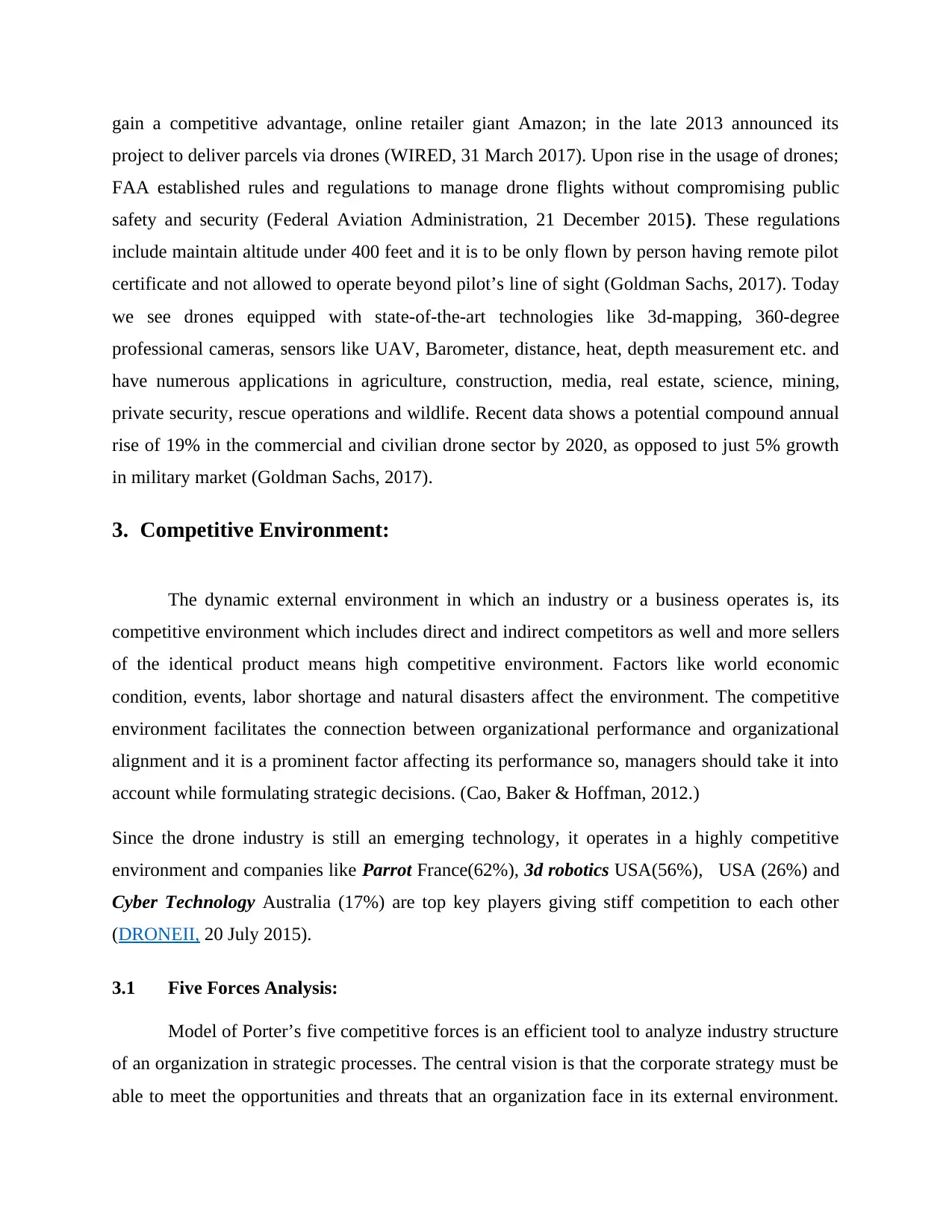
gain a competitive advantage, online retailer giant Amazon; in the late 2013 announced its
project to deliver parcels via drones (WIRED, 31 March 2017). Upon rise in the usage of drones;
FAA established rules and regulations to manage drone flights without compromising public
safety and security (Federal Aviation Administration, 21 December 2015). These regulations
include maintain altitude under 400 feet and it is to be only flown by person having remote pilot
certificate and not allowed to operate beyond pilot’s line of sight (Goldman Sachs, 2017). Today
we see drones equipped with state-of-the-art technologies like 3d-mapping, 360-degree
professional cameras, sensors like UAV, Barometer, distance, heat, depth measurement etc. and
have numerous applications in agriculture, construction, media, real estate, science, mining,
private security, rescue operations and wildlife. Recent data shows a potential compound annual
rise of 19% in the commercial and civilian drone sector by 2020, as opposed to just 5% growth
in military market (Goldman Sachs, 2017).
3. Competitive Environment:
The dynamic external environment in which an industry or a business operates is, its
competitive environment which includes direct and indirect competitors as well and more sellers
of the identical product means high competitive environment. Factors like world economic
condition, events, labor shortage and natural disasters affect the environment. The competitive
environment facilitates the connection between organizational performance and organizational
alignment and it is a prominent factor affecting its performance so, managers should take it into
account while formulating strategic decisions. (Cao, Baker & Hoffman, 2012.)
Since the drone industry is still an emerging technology, it operates in a highly competitive
environment and companies like Parrot France(62%), 3d robotics USA(56%), USA (26%) and
Cyber Technology Australia (17%) are top key players giving stiff competition to each other
(DRONEII, 20 July 2015).
3.1 Five Forces Analysis:
Model of Porter’s five competitive forces is an efficient tool to analyze industry structure
of an organization in strategic processes. The central vision is that the corporate strategy must be
able to meet the opportunities and threats that an organization face in its external environment.
project to deliver parcels via drones (WIRED, 31 March 2017). Upon rise in the usage of drones;
FAA established rules and regulations to manage drone flights without compromising public
safety and security (Federal Aviation Administration, 21 December 2015). These regulations
include maintain altitude under 400 feet and it is to be only flown by person having remote pilot
certificate and not allowed to operate beyond pilot’s line of sight (Goldman Sachs, 2017). Today
we see drones equipped with state-of-the-art technologies like 3d-mapping, 360-degree
professional cameras, sensors like UAV, Barometer, distance, heat, depth measurement etc. and
have numerous applications in agriculture, construction, media, real estate, science, mining,
private security, rescue operations and wildlife. Recent data shows a potential compound annual
rise of 19% in the commercial and civilian drone sector by 2020, as opposed to just 5% growth
in military market (Goldman Sachs, 2017).
3. Competitive Environment:
The dynamic external environment in which an industry or a business operates is, its
competitive environment which includes direct and indirect competitors as well and more sellers
of the identical product means high competitive environment. Factors like world economic
condition, events, labor shortage and natural disasters affect the environment. The competitive
environment facilitates the connection between organizational performance and organizational
alignment and it is a prominent factor affecting its performance so, managers should take it into
account while formulating strategic decisions. (Cao, Baker & Hoffman, 2012.)
Since the drone industry is still an emerging technology, it operates in a highly competitive
environment and companies like Parrot France(62%), 3d robotics USA(56%), USA (26%) and
Cyber Technology Australia (17%) are top key players giving stiff competition to each other
(DRONEII, 20 July 2015).
3.1 Five Forces Analysis:
Model of Porter’s five competitive forces is an efficient tool to analyze industry structure
of an organization in strategic processes. The central vision is that the corporate strategy must be
able to meet the opportunities and threats that an organization face in its external environment.
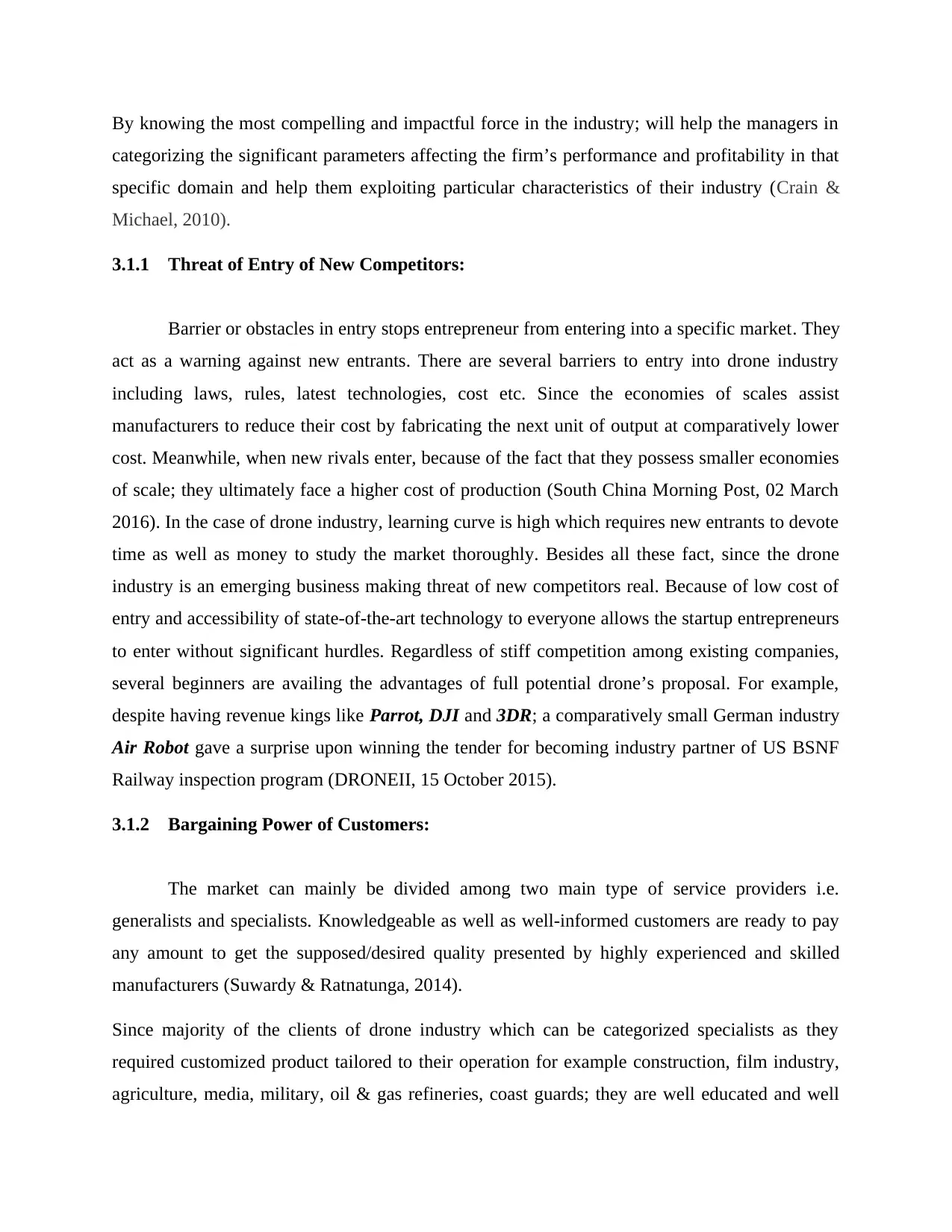
By knowing the most compelling and impactful force in the industry; will help the managers in
categorizing the significant parameters affecting the firm’s performance and profitability in that
specific domain and help them exploiting particular characteristics of their industry (Crain &
Michael, 2010).
3.1.1 Threat of Entry of New Competitors:
Barrier or obstacles in entry stops entrepreneur from entering into a specific market. They
act as a warning against new entrants. There are several barriers to entry into drone industry
including laws, rules, latest technologies, cost etc. Since the economies of scales assist
manufacturers to reduce their cost by fabricating the next unit of output at comparatively lower
cost. Meanwhile, when new rivals enter, because of the fact that they possess smaller economies
of scale; they ultimately face a higher cost of production (South China Morning Post, 02 March
2016). In the case of drone industry, learning curve is high which requires new entrants to devote
time as well as money to study the market thoroughly. Besides all these fact, since the drone
industry is an emerging business making threat of new competitors real. Because of low cost of
entry and accessibility of state-of-the-art technology to everyone allows the startup entrepreneurs
to enter without significant hurdles. Regardless of stiff competition among existing companies,
several beginners are availing the advantages of full potential drone’s proposal. For example,
despite having revenue kings like Parrot, DJI and 3DR; a comparatively small German industry
Air Robot gave a surprise upon winning the tender for becoming industry partner of US BSNF
Railway inspection program (DRONEII, 15 October 2015).
3.1.2 Bargaining Power of Customers:
The market can mainly be divided among two main type of service providers i.e.
generalists and specialists. Knowledgeable as well as well-informed customers are ready to pay
any amount to get the supposed/desired quality presented by highly experienced and skilled
manufacturers (Suwardy & Ratnatunga, 2014).
Since majority of the clients of drone industry which can be categorized specialists as they
required customized product tailored to their operation for example construction, film industry,
agriculture, media, military, oil & gas refineries, coast guards; they are well educated and well
categorizing the significant parameters affecting the firm’s performance and profitability in that
specific domain and help them exploiting particular characteristics of their industry (Crain &
Michael, 2010).
3.1.1 Threat of Entry of New Competitors:
Barrier or obstacles in entry stops entrepreneur from entering into a specific market. They
act as a warning against new entrants. There are several barriers to entry into drone industry
including laws, rules, latest technologies, cost etc. Since the economies of scales assist
manufacturers to reduce their cost by fabricating the next unit of output at comparatively lower
cost. Meanwhile, when new rivals enter, because of the fact that they possess smaller economies
of scale; they ultimately face a higher cost of production (South China Morning Post, 02 March
2016). In the case of drone industry, learning curve is high which requires new entrants to devote
time as well as money to study the market thoroughly. Besides all these fact, since the drone
industry is an emerging business making threat of new competitors real. Because of low cost of
entry and accessibility of state-of-the-art technology to everyone allows the startup entrepreneurs
to enter without significant hurdles. Regardless of stiff competition among existing companies,
several beginners are availing the advantages of full potential drone’s proposal. For example,
despite having revenue kings like Parrot, DJI and 3DR; a comparatively small German industry
Air Robot gave a surprise upon winning the tender for becoming industry partner of US BSNF
Railway inspection program (DRONEII, 15 October 2015).
3.1.2 Bargaining Power of Customers:
The market can mainly be divided among two main type of service providers i.e.
generalists and specialists. Knowledgeable as well as well-informed customers are ready to pay
any amount to get the supposed/desired quality presented by highly experienced and skilled
manufacturers (Suwardy & Ratnatunga, 2014).
Since majority of the clients of drone industry which can be categorized specialists as they
required customized product tailored to their operation for example construction, film industry,
agriculture, media, military, oil & gas refineries, coast guards; they are well educated and well
⊘ This is a preview!⊘
Do you want full access?
Subscribe today to unlock all pages.

Trusted by 1+ million students worldwide
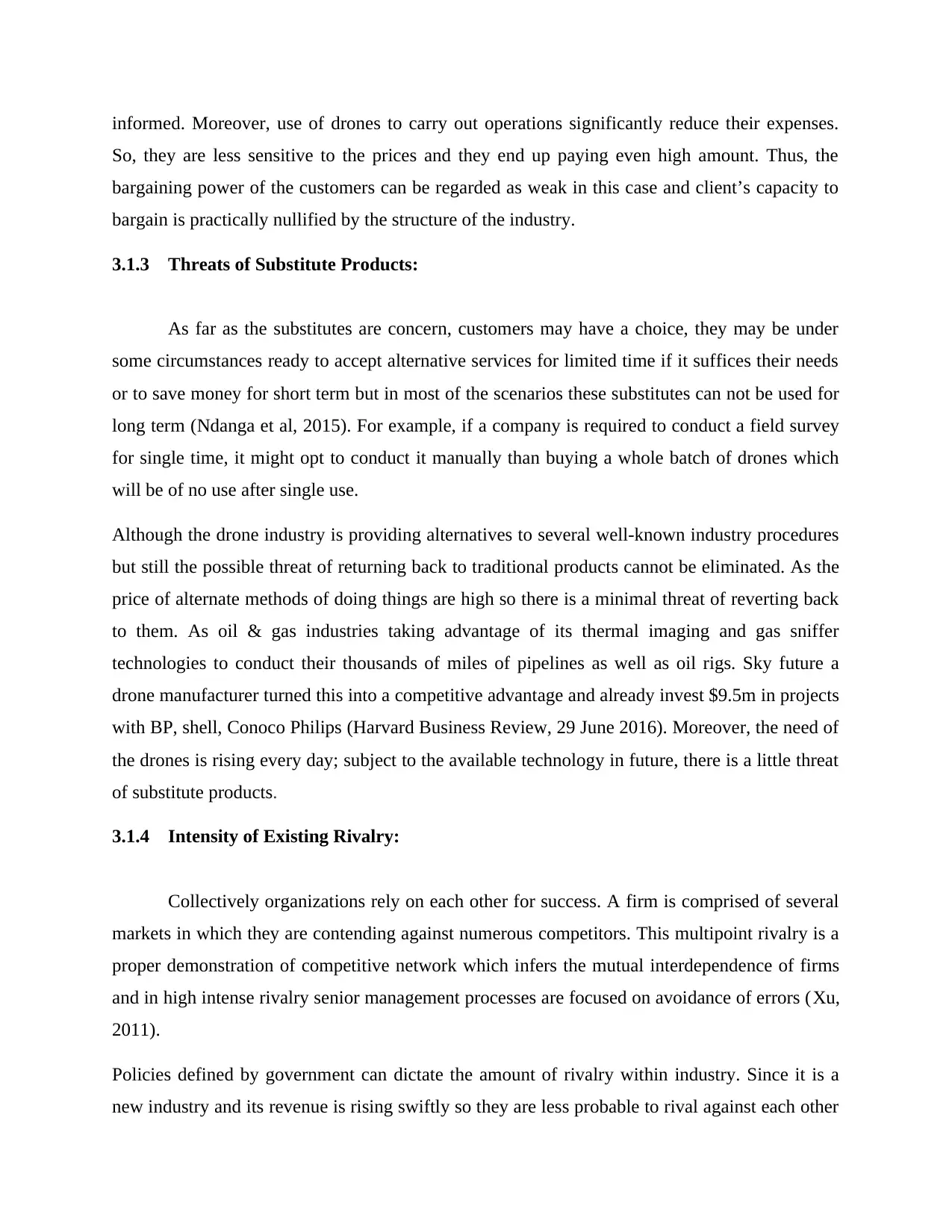
informed. Moreover, use of drones to carry out operations significantly reduce their expenses.
So, they are less sensitive to the prices and they end up paying even high amount. Thus, the
bargaining power of the customers can be regarded as weak in this case and client’s capacity to
bargain is practically nullified by the structure of the industry.
3.1.3 Threats of Substitute Products:
As far as the substitutes are concern, customers may have a choice, they may be under
some circumstances ready to accept alternative services for limited time if it suffices their needs
or to save money for short term but in most of the scenarios these substitutes can not be used for
long term (Ndanga et al, 2015). For example, if a company is required to conduct a field survey
for single time, it might opt to conduct it manually than buying a whole batch of drones which
will be of no use after single use.
Although the drone industry is providing alternatives to several well-known industry procedures
but still the possible threat of returning back to traditional products cannot be eliminated. As the
price of alternate methods of doing things are high so there is a minimal threat of reverting back
to them. As oil & gas industries taking advantage of its thermal imaging and gas sniffer
technologies to conduct their thousands of miles of pipelines as well as oil rigs. Sky future a
drone manufacturer turned this into a competitive advantage and already invest $9.5m in projects
with BP, shell, Conoco Philips (Harvard Business Review, 29 June 2016). Moreover, the need of
the drones is rising every day; subject to the available technology in future, there is a little threat
of substitute products.
3.1.4 Intensity of Existing Rivalry:
Collectively organizations rely on each other for success. A firm is comprised of several
markets in which they are contending against numerous competitors. This multipoint rivalry is a
proper demonstration of competitive network which infers the mutual interdependence of firms
and in high intense rivalry senior management processes are focused on avoidance of errors (Xu,
2011).
Policies defined by government can dictate the amount of rivalry within industry. Since it is a
new industry and its revenue is rising swiftly so they are less probable to rival against each other
So, they are less sensitive to the prices and they end up paying even high amount. Thus, the
bargaining power of the customers can be regarded as weak in this case and client’s capacity to
bargain is practically nullified by the structure of the industry.
3.1.3 Threats of Substitute Products:
As far as the substitutes are concern, customers may have a choice, they may be under
some circumstances ready to accept alternative services for limited time if it suffices their needs
or to save money for short term but in most of the scenarios these substitutes can not be used for
long term (Ndanga et al, 2015). For example, if a company is required to conduct a field survey
for single time, it might opt to conduct it manually than buying a whole batch of drones which
will be of no use after single use.
Although the drone industry is providing alternatives to several well-known industry procedures
but still the possible threat of returning back to traditional products cannot be eliminated. As the
price of alternate methods of doing things are high so there is a minimal threat of reverting back
to them. As oil & gas industries taking advantage of its thermal imaging and gas sniffer
technologies to conduct their thousands of miles of pipelines as well as oil rigs. Sky future a
drone manufacturer turned this into a competitive advantage and already invest $9.5m in projects
with BP, shell, Conoco Philips (Harvard Business Review, 29 June 2016). Moreover, the need of
the drones is rising every day; subject to the available technology in future, there is a little threat
of substitute products.
3.1.4 Intensity of Existing Rivalry:
Collectively organizations rely on each other for success. A firm is comprised of several
markets in which they are contending against numerous competitors. This multipoint rivalry is a
proper demonstration of competitive network which infers the mutual interdependence of firms
and in high intense rivalry senior management processes are focused on avoidance of errors (Xu,
2011).
Policies defined by government can dictate the amount of rivalry within industry. Since it is a
new industry and its revenue is rising swiftly so they are less probable to rival against each other
Paraphrase This Document
Need a fresh take? Get an instant paraphrase of this document with our AI Paraphraser
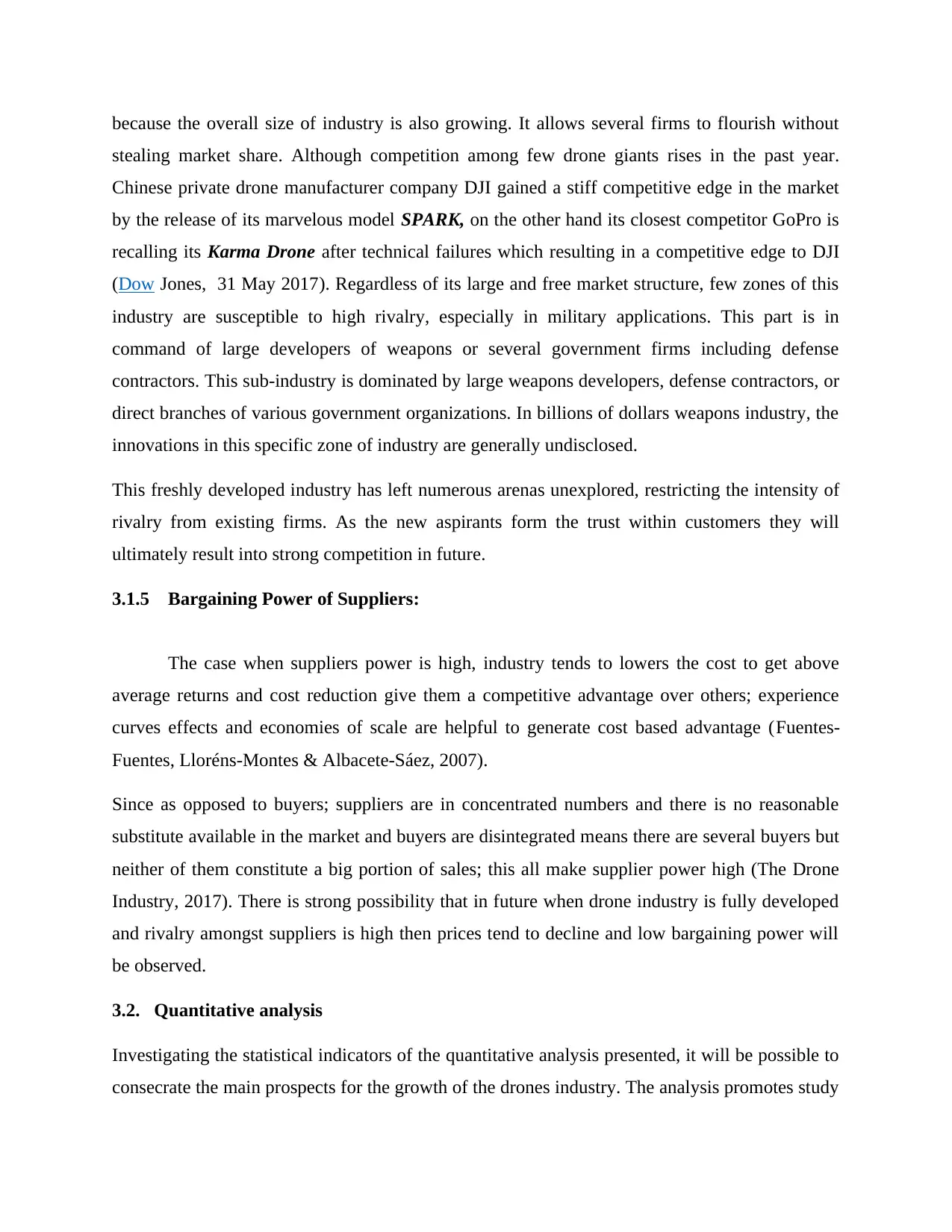
because the overall size of industry is also growing. It allows several firms to flourish without
stealing market share. Although competition among few drone giants rises in the past year.
Chinese private drone manufacturer company DJI gained a stiff competitive edge in the market
by the release of its marvelous model SPARK, on the other hand its closest competitor GoPro is
recalling its Karma Drone after technical failures which resulting in a competitive edge to DJI
(Dow Jones, 31 May 2017). Regardless of its large and free market structure, few zones of this
industry are susceptible to high rivalry, especially in military applications. This part is in
command of large developers of weapons or several government firms including defense
contractors. This sub-industry is dominated by large weapons developers, defense contractors, or
direct branches of various government organizations. In billions of dollars weapons industry, the
innovations in this specific zone of industry are generally undisclosed.
This freshly developed industry has left numerous arenas unexplored, restricting the intensity of
rivalry from existing firms. As the new aspirants form the trust within customers they will
ultimately result into strong competition in future.
3.1.5 Bargaining Power of Suppliers:
The case when suppliers power is high, industry tends to lowers the cost to get above
average returns and cost reduction give them a competitive advantage over others; experience
curves effects and economies of scale are helpful to generate cost based advantage (Fuentes-
Fuentes, Lloréns-Montes & Albacete-Sáez, 2007).
Since as opposed to buyers; suppliers are in concentrated numbers and there is no reasonable
substitute available in the market and buyers are disintegrated means there are several buyers but
neither of them constitute a big portion of sales; this all make supplier power high (The Drone
Industry, 2017). There is strong possibility that in future when drone industry is fully developed
and rivalry amongst suppliers is high then prices tend to decline and low bargaining power will
be observed.
3.2. Quantitative analysis
Investigating the statistical indicators of the quantitative analysis presented, it will be possible to
consecrate the main prospects for the growth of the drones industry. The analysis promotes study
stealing market share. Although competition among few drone giants rises in the past year.
Chinese private drone manufacturer company DJI gained a stiff competitive edge in the market
by the release of its marvelous model SPARK, on the other hand its closest competitor GoPro is
recalling its Karma Drone after technical failures which resulting in a competitive edge to DJI
(Dow Jones, 31 May 2017). Regardless of its large and free market structure, few zones of this
industry are susceptible to high rivalry, especially in military applications. This part is in
command of large developers of weapons or several government firms including defense
contractors. This sub-industry is dominated by large weapons developers, defense contractors, or
direct branches of various government organizations. In billions of dollars weapons industry, the
innovations in this specific zone of industry are generally undisclosed.
This freshly developed industry has left numerous arenas unexplored, restricting the intensity of
rivalry from existing firms. As the new aspirants form the trust within customers they will
ultimately result into strong competition in future.
3.1.5 Bargaining Power of Suppliers:
The case when suppliers power is high, industry tends to lowers the cost to get above
average returns and cost reduction give them a competitive advantage over others; experience
curves effects and economies of scale are helpful to generate cost based advantage (Fuentes-
Fuentes, Lloréns-Montes & Albacete-Sáez, 2007).
Since as opposed to buyers; suppliers are in concentrated numbers and there is no reasonable
substitute available in the market and buyers are disintegrated means there are several buyers but
neither of them constitute a big portion of sales; this all make supplier power high (The Drone
Industry, 2017). There is strong possibility that in future when drone industry is fully developed
and rivalry amongst suppliers is high then prices tend to decline and low bargaining power will
be observed.
3.2. Quantitative analysis
Investigating the statistical indicators of the quantitative analysis presented, it will be possible to
consecrate the main prospects for the growth of the drones industry. The analysis promotes study
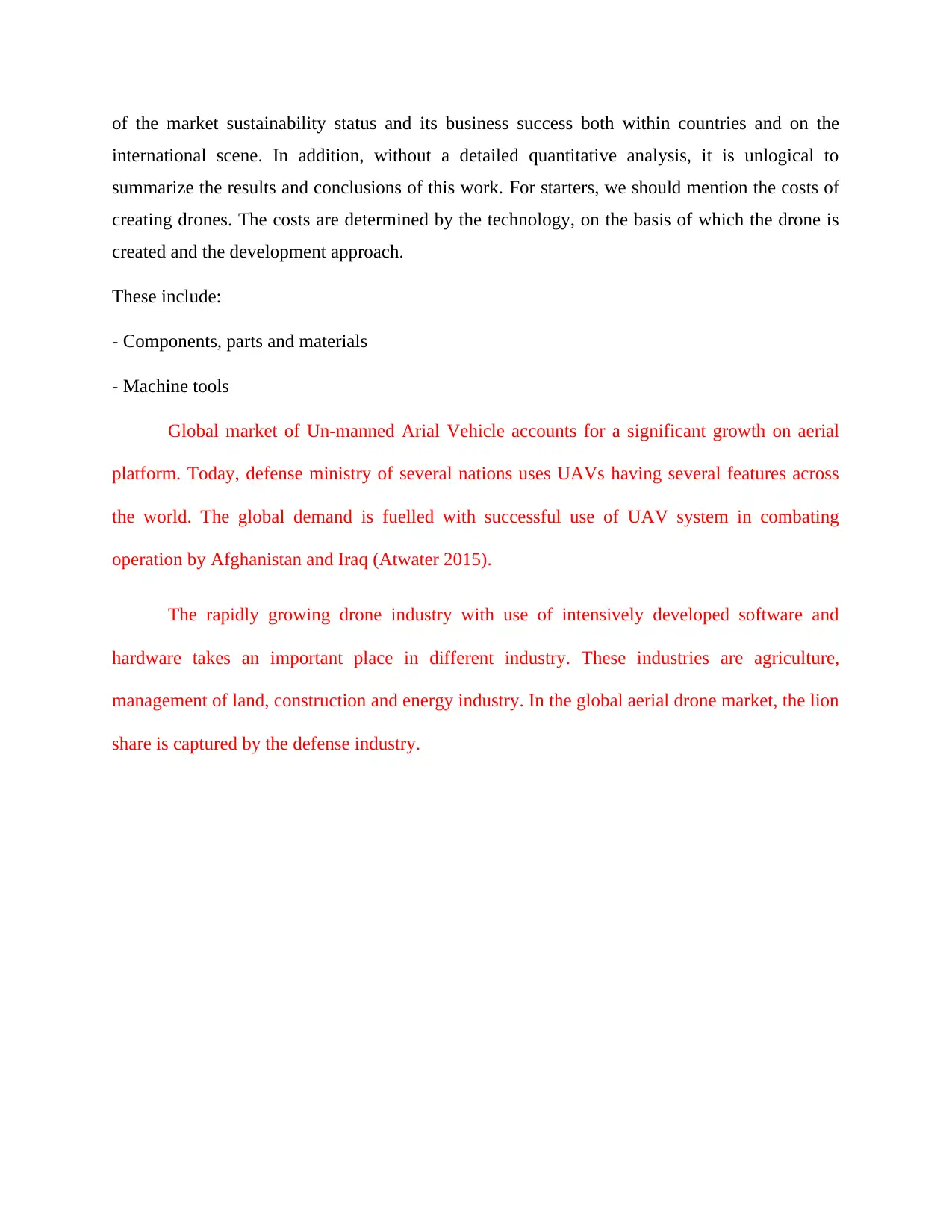
of the market sustainability status and its business success both within countries and on the
international scene. In addition, without a detailed quantitative analysis, it is unlogical to
summarize the results and conclusions of this work. For starters, we should mention the costs of
creating drones. The costs are determined by the technology, on the basis of which the drone is
created and the development approach.
These include:
- Components, parts and materials
- Machine tools
Global market of Un-manned Arial Vehicle accounts for a significant growth on aerial
platform. Today, defense ministry of several nations uses UAVs having several features across
the world. The global demand is fuelled with successful use of UAV system in combating
operation by Afghanistan and Iraq (Atwater 2015).
The rapidly growing drone industry with use of intensively developed software and
hardware takes an important place in different industry. These industries are agriculture,
management of land, construction and energy industry. In the global aerial drone market, the lion
share is captured by the defense industry.
international scene. In addition, without a detailed quantitative analysis, it is unlogical to
summarize the results and conclusions of this work. For starters, we should mention the costs of
creating drones. The costs are determined by the technology, on the basis of which the drone is
created and the development approach.
These include:
- Components, parts and materials
- Machine tools
Global market of Un-manned Arial Vehicle accounts for a significant growth on aerial
platform. Today, defense ministry of several nations uses UAVs having several features across
the world. The global demand is fuelled with successful use of UAV system in combating
operation by Afghanistan and Iraq (Atwater 2015).
The rapidly growing drone industry with use of intensively developed software and
hardware takes an important place in different industry. These industries are agriculture,
management of land, construction and energy industry. In the global aerial drone market, the lion
share is captured by the defense industry.
⊘ This is a preview!⊘
Do you want full access?
Subscribe today to unlock all pages.

Trusted by 1+ million students worldwide
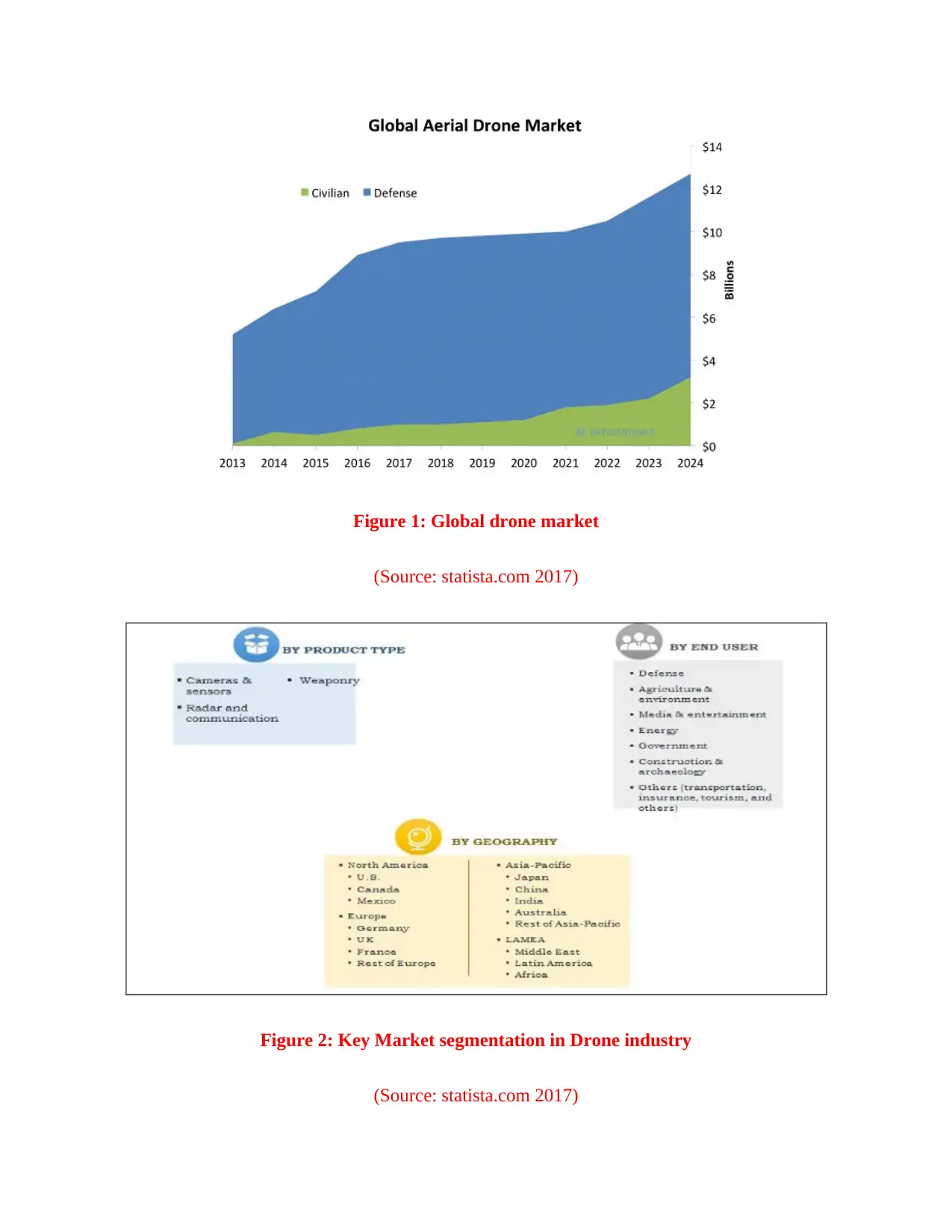
Figure 1: Global drone market
(Source: statista.com 2017)
Figure 2: Key Market segmentation in Drone industry
(Source: statista.com 2017)
(Source: statista.com 2017)
Figure 2: Key Market segmentation in Drone industry
(Source: statista.com 2017)
Paraphrase This Document
Need a fresh take? Get an instant paraphrase of this document with our AI Paraphraser
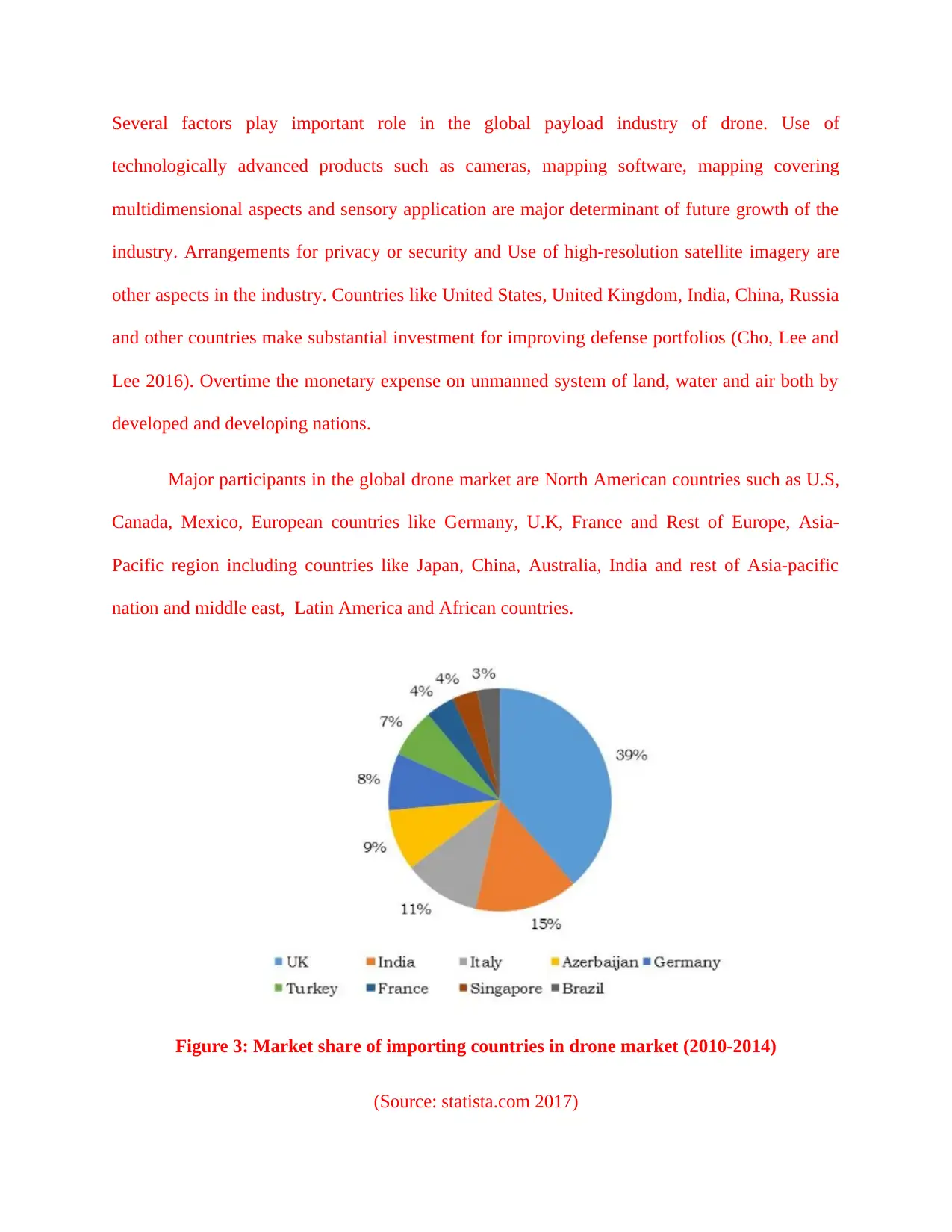
Several factors play important role in the global payload industry of drone. Use of
technologically advanced products such as cameras, mapping software, mapping covering
multidimensional aspects and sensory application are major determinant of future growth of the
industry. Arrangements for privacy or security and Use of high-resolution satellite imagery are
other aspects in the industry. Countries like United States, United Kingdom, India, China, Russia
and other countries make substantial investment for improving defense portfolios (Cho, Lee and
Lee 2016). Overtime the monetary expense on unmanned system of land, water and air both by
developed and developing nations.
Major participants in the global drone market are North American countries such as U.S,
Canada, Mexico, European countries like Germany, U.K, France and Rest of Europe, Asia-
Pacific region including countries like Japan, China, Australia, India and rest of Asia-pacific
nation and middle east, Latin America and African countries.
Figure 3: Market share of importing countries in drone market (2010-2014)
(Source: statista.com 2017)
technologically advanced products such as cameras, mapping software, mapping covering
multidimensional aspects and sensory application are major determinant of future growth of the
industry. Arrangements for privacy or security and Use of high-resolution satellite imagery are
other aspects in the industry. Countries like United States, United Kingdom, India, China, Russia
and other countries make substantial investment for improving defense portfolios (Cho, Lee and
Lee 2016). Overtime the monetary expense on unmanned system of land, water and air both by
developed and developing nations.
Major participants in the global drone market are North American countries such as U.S,
Canada, Mexico, European countries like Germany, U.K, France and Rest of Europe, Asia-
Pacific region including countries like Japan, China, Australia, India and rest of Asia-pacific
nation and middle east, Latin America and African countries.
Figure 3: Market share of importing countries in drone market (2010-2014)
(Source: statista.com 2017)
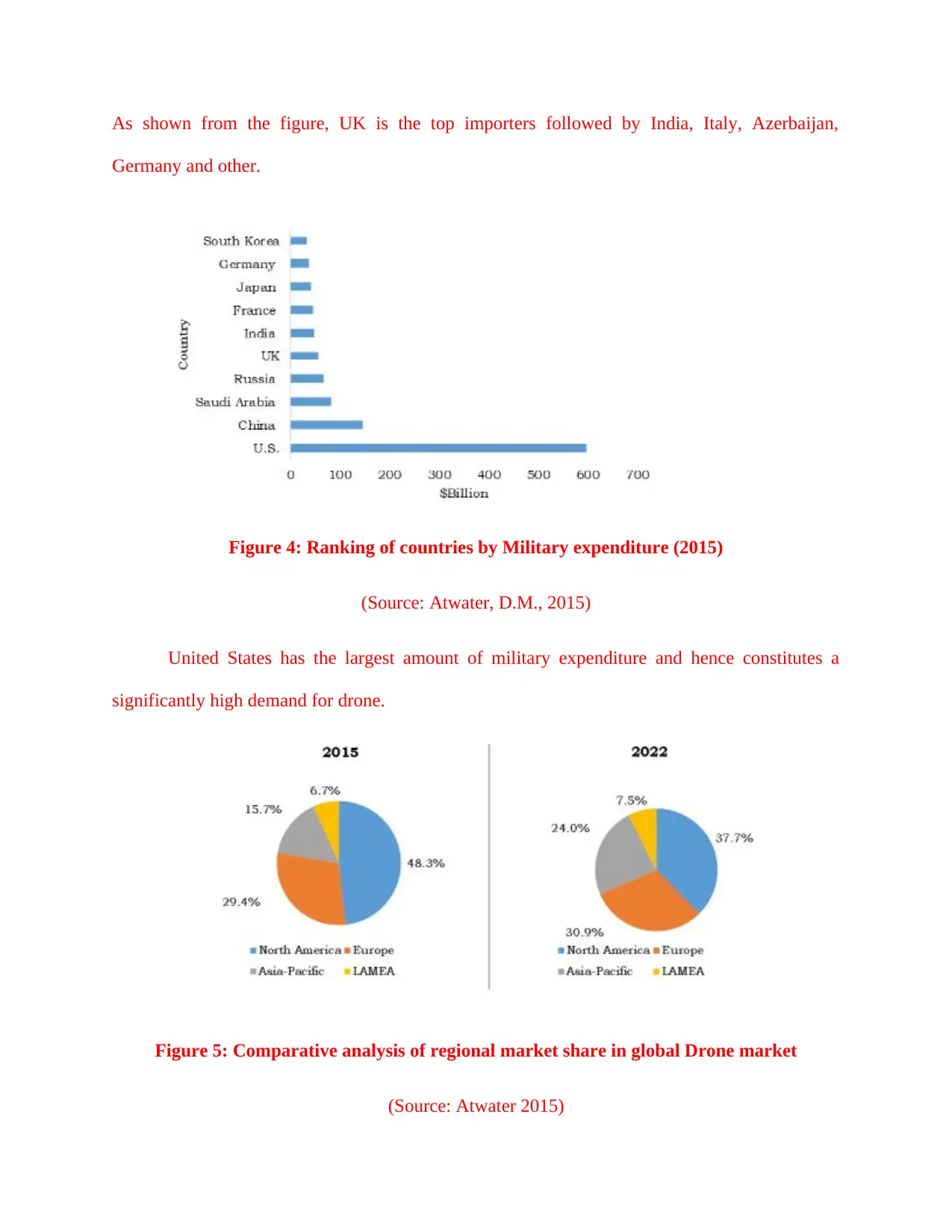
As shown from the figure, UK is the top importers followed by India, Italy, Azerbaijan,
Germany and other.
Figure 4: Ranking of countries by Military expenditure (2015)
(Source: Atwater, D.M., 2015)
United States has the largest amount of military expenditure and hence constitutes a
significantly high demand for drone.
Figure 5: Comparative analysis of regional market share in global Drone market
(Source: Atwater 2015)
Germany and other.
Figure 4: Ranking of countries by Military expenditure (2015)
(Source: Atwater, D.M., 2015)
United States has the largest amount of military expenditure and hence constitutes a
significantly high demand for drone.
Figure 5: Comparative analysis of regional market share in global Drone market
(Source: Atwater 2015)
⊘ This is a preview!⊘
Do you want full access?
Subscribe today to unlock all pages.

Trusted by 1+ million students worldwide
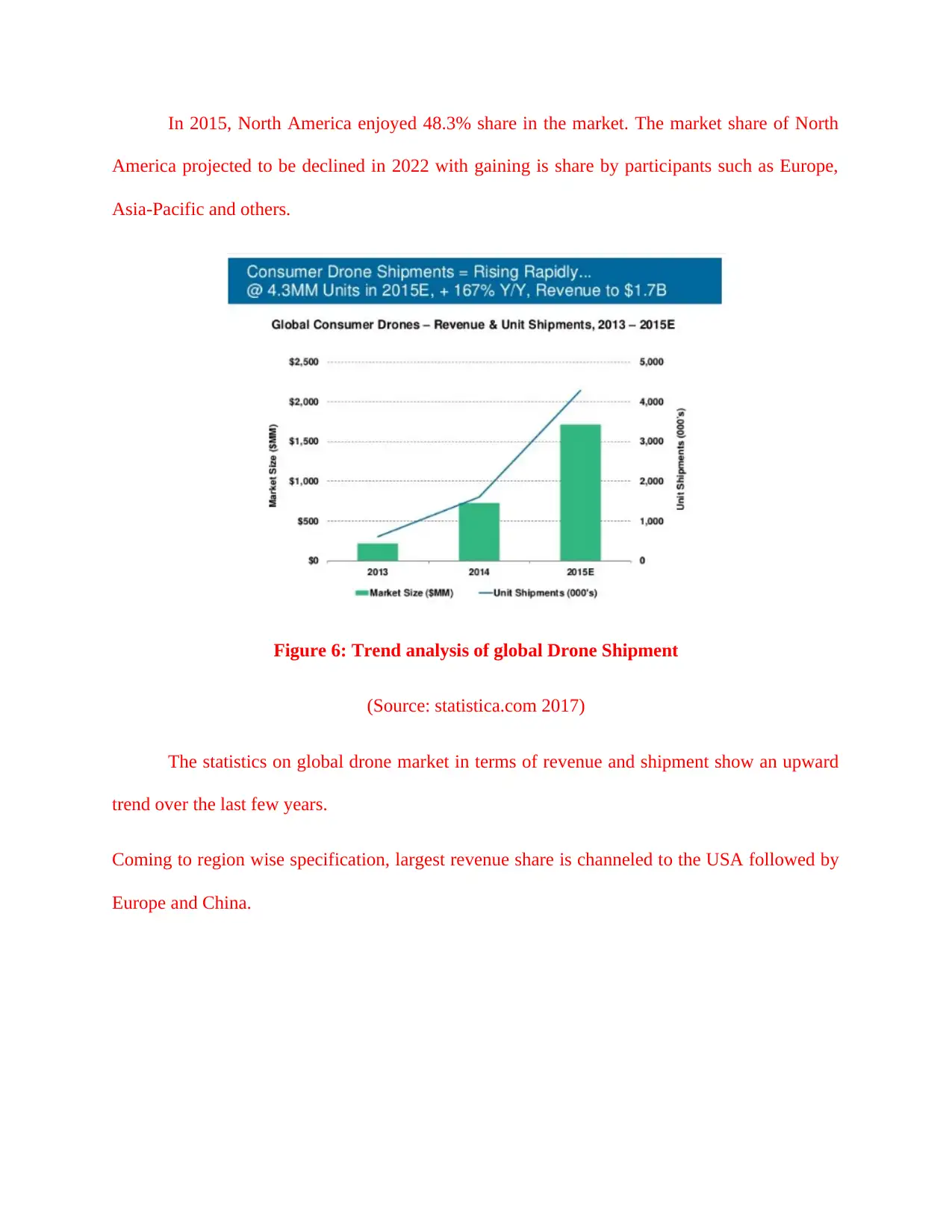
In 2015, North America enjoyed 48.3% share in the market. The market share of North
America projected to be declined in 2022 with gaining is share by participants such as Europe,
Asia-Pacific and others.
Figure 6: Trend analysis of global Drone Shipment
(Source: statistica.com 2017)
The statistics on global drone market in terms of revenue and shipment show an upward
trend over the last few years.
Coming to region wise specification, largest revenue share is channeled to the USA followed by
Europe and China.
America projected to be declined in 2022 with gaining is share by participants such as Europe,
Asia-Pacific and others.
Figure 6: Trend analysis of global Drone Shipment
(Source: statistica.com 2017)
The statistics on global drone market in terms of revenue and shipment show an upward
trend over the last few years.
Coming to region wise specification, largest revenue share is channeled to the USA followed by
Europe and China.
Paraphrase This Document
Need a fresh take? Get an instant paraphrase of this document with our AI Paraphraser
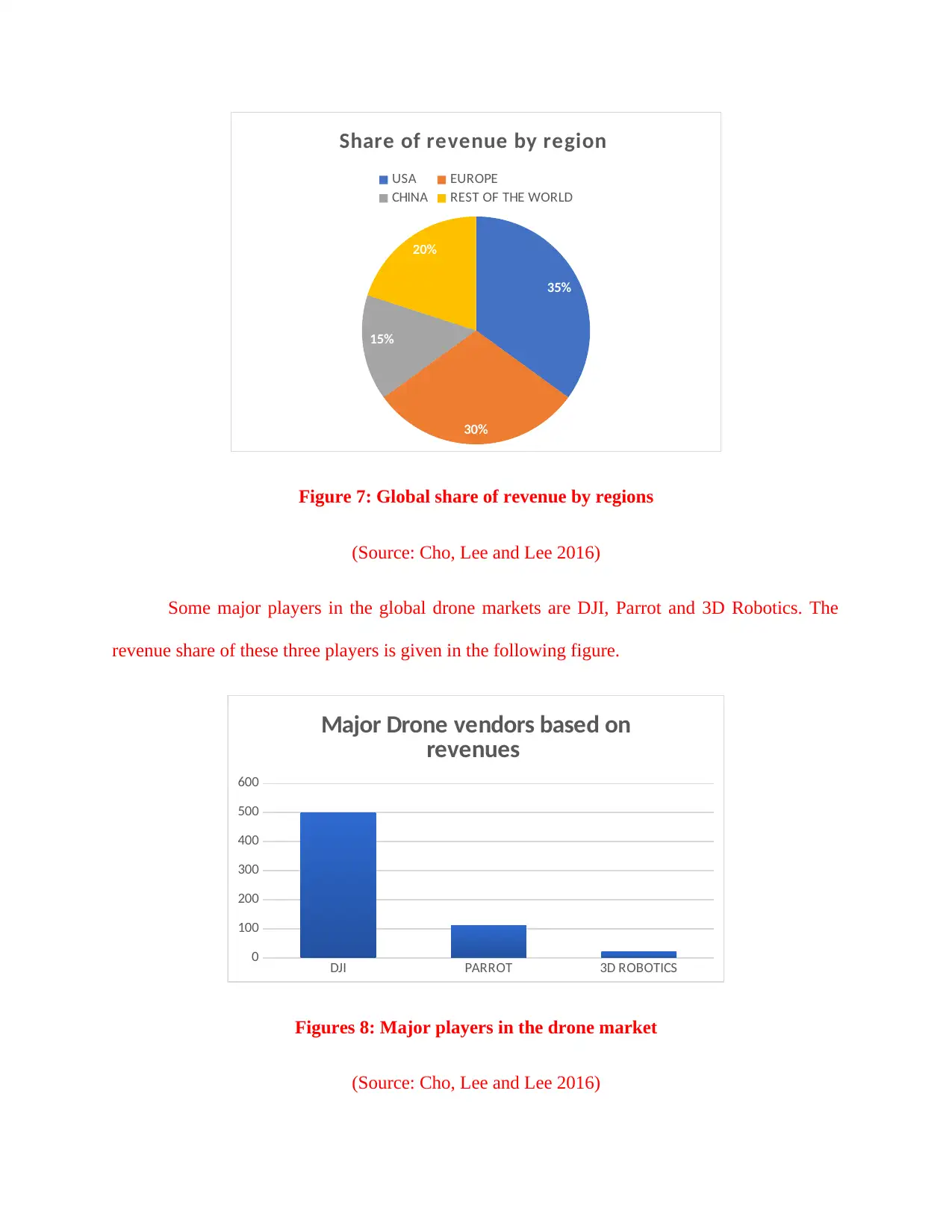
35%
30%
15%
20%
Share of revenue by region
USA EUROPE
CHINA REST OF THE WORLD
Figure 7: Global share of revenue by regions
(Source: Cho, Lee and Lee 2016)
Some major players in the global drone markets are DJI, Parrot and 3D Robotics. The
revenue share of these three players is given in the following figure.
DJI PARROT 3D ROBOTICS
0
100
200
300
400
500
600
Major Drone vendors based on
revenues
Figures 8: Major players in the drone market
(Source: Cho, Lee and Lee 2016)
30%
15%
20%
Share of revenue by region
USA EUROPE
CHINA REST OF THE WORLD
Figure 7: Global share of revenue by regions
(Source: Cho, Lee and Lee 2016)
Some major players in the global drone markets are DJI, Parrot and 3D Robotics. The
revenue share of these three players is given in the following figure.
DJI PARROT 3D ROBOTICS
0
100
200
300
400
500
600
Major Drone vendors based on
revenues
Figures 8: Major players in the drone market
(Source: Cho, Lee and Lee 2016)
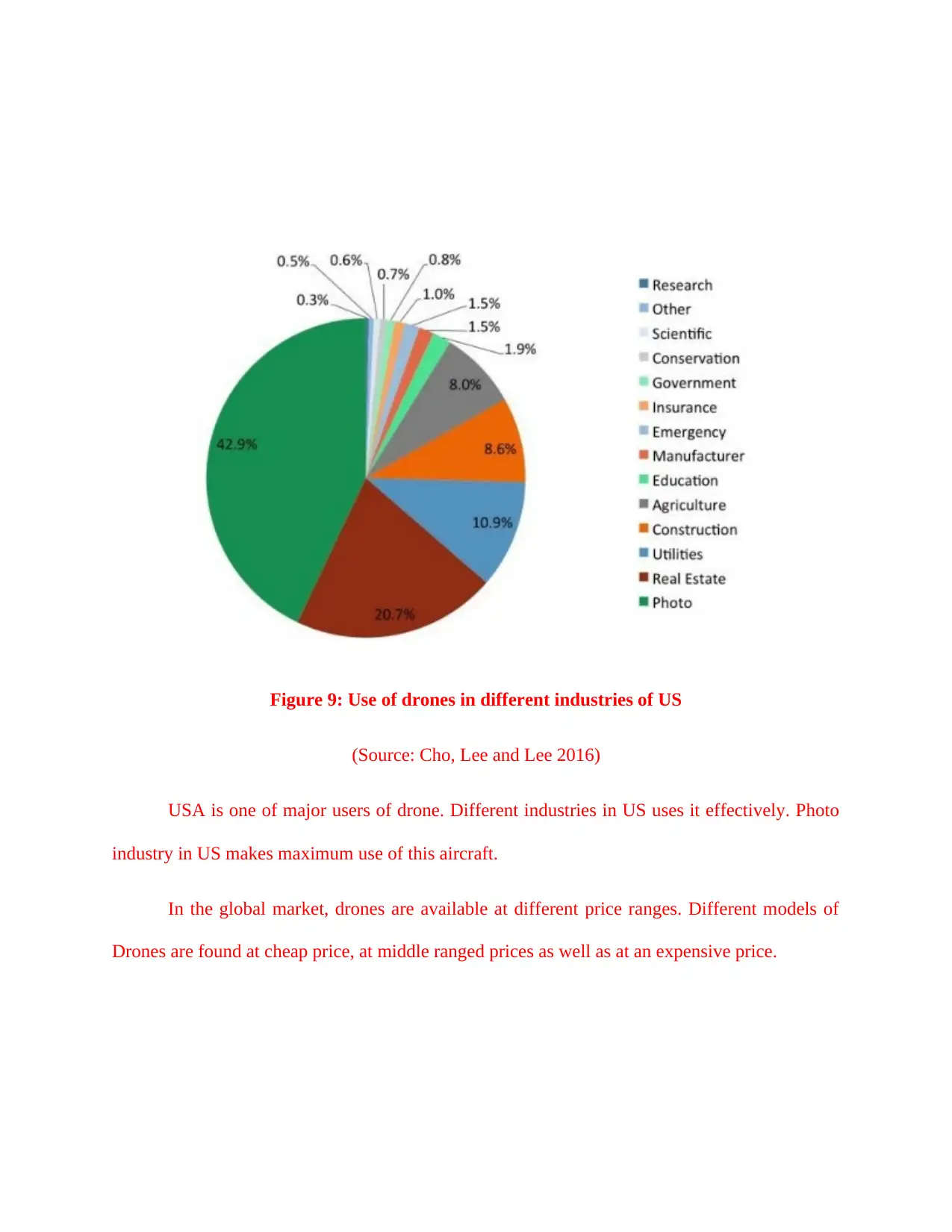
Figure 9: Use of drones in different industries of US
(Source: Cho, Lee and Lee 2016)
USA is one of major users of drone. Different industries in US uses it effectively. Photo
industry in US makes maximum use of this aircraft.
In the global market, drones are available at different price ranges. Different models of
Drones are found at cheap price, at middle ranged prices as well as at an expensive price.
(Source: Cho, Lee and Lee 2016)
USA is one of major users of drone. Different industries in US uses it effectively. Photo
industry in US makes maximum use of this aircraft.
In the global market, drones are available at different price ranges. Different models of
Drones are found at cheap price, at middle ranged prices as well as at an expensive price.
⊘ This is a preview!⊘
Do you want full access?
Subscribe today to unlock all pages.

Trusted by 1+ million students worldwide
1 out of 22
Your All-in-One AI-Powered Toolkit for Academic Success.
+13062052269
info@desklib.com
Available 24*7 on WhatsApp / Email
![[object Object]](/_next/static/media/star-bottom.7253800d.svg)
Unlock your academic potential
Copyright © 2020–2025 A2Z Services. All Rights Reserved. Developed and managed by ZUCOL.